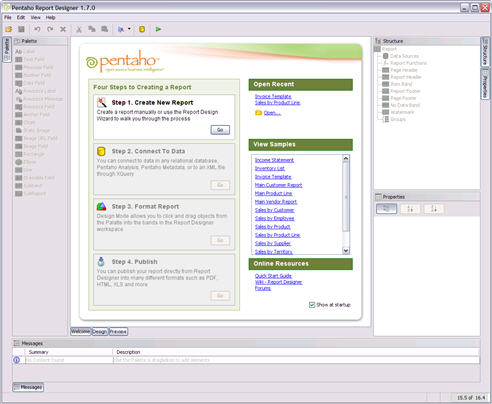...
The latest distribution for Report Designer is available on SourceForge at http://sourceforge.net/project/showfiles.php?group_id=140317. Download the Report Designer as part of the Pentaho Open BI Suite (pentaho_demo_hsqldb-1.6.0.GA.863.zip), if you plan to publish your reports using the BI Platform provided by Pentaho. To download the Report Designer as a standalone application, go to http://sourceforge.net/project/showfiles.php?group_id=140317&package_id=192362. To follow the instructions and tutorials included in the Report Designer documentation, you must install the Hypersonic distribution of Sample Data (pentaho_sample_data-1.6.0.GA.863.zip).
System Requirements
- Windows XP Professional, Mac OSX 10.4.6, SUSE Linux
...
- 10.1, Red Hat Enterprise Linux 5.
Note: Other versions of the above-listed Linux distributions, and other distributions entirely, will probably work with Report Designer. However, the distros listed here are tested and supported by Pentaho.
- Requires the 1.5.0_06 Java Runtime Environment (JRE)
Installing Report Designer
...
- Extract contents of the zip file into a folder.
- Read the Readme for important updates.
- In the Report Designer folder, click the file that is most appropriate for your operating system.
- Windows - ReportDesigner.exe
- Linux - startdesigner_linux.sh
- Mac OS X - Report Designer.app
The Pentaho Report Designer Version Checker
...
- Go to USER_HOME/.Report
- Find the file workspaceSettings.xml.
- Find the element, <property name="useVersionChecker">false</property>.
- Change the property value from "true" to false.
...
Report Designer Start Up
The Report Designer displays a Welcome page and a default workspace at start up. The Welcome page provides you with a brief introduction of the Report Designer and some instructions for getting started. The Welcome page also provides access to sample reports and recently opened reports. Click Design to open the report workspace.
In the center of the workspace a large white area represents the main working area where you build a report. On the left side of the Report Designer workspace is the Palette that lists the graphical elements of the report. On the right side of the workspace, the Structure panel allows you to see a hierarchical representation of the report. The Properties panel allows you to adjust the settings of the currently available selection. In the lower portion of the workspace, the Messages panel displays useful information, hints, warnings, and errors that apply to your current report definition.
The Data Model
Warning: Reports created with WAQR will not properly open in Pentaho Report Designer because of an XML syntax error. WAQR creates reports with <cdata> tags around each line, but Report Designer is expecting only one <cdata> tag around the entire file. If you want to open a WAQR-created report in Report Designer, you will have to edit the .xaction file by hand using a text or XML editor and remove all of the superfluous <cdata> tags, leaving only one tag around the entire file.
A report generally consists of data supplied by a database in the form of a table and a report definition that defines how the report must be formatted or printed.
...
- In the Structure panel, right-click Data Sources and select Add Data Source (formerly Add Pentaho Dataset). A window opens where you can configure the query used in the data source.
- Select SampleData and click the Query Designer. Make sure your Hypersonic database is running before doing so.
- Select PUBLIC from the Choose Schema list box. The SQLeonardo window is loaded. From this window, you can select the tables/views to be included in the data source.
- Select the PRODUCTS table by clicking PREVIEW. This allows you to visualize the data in the table quickly.
- Click OK to close both windows.
The data source is added to the report. The Properties tool window displays the available columns and the data type of each column. Click Configure to change the configuration of a data source. The data source is now set up and installed correctly. You must now define the look of the report.
The Report Definition
The report definition is what you compose in the main area of the graphical Report Designer. This definition provides the reporting engine with the location of each field on the report. The report definition consist of several sections called bands, such bands may include a report header, a page header, the item band and others.
The following image represents a schematic report as it may appear on the page:
The standard bands available in all reports are marked with different colors in the following image.
Red: the page header band. This band is usually printed at the top of each page
Green: the report header band. This band is printed once when the report starts
Blue: the item band. This band is printed for each row available in the data table
Turquoise: the report footer band. This band is printed once at the end of the report
Orange: the page footer band. This band is printed once at the bottom of each page
...

